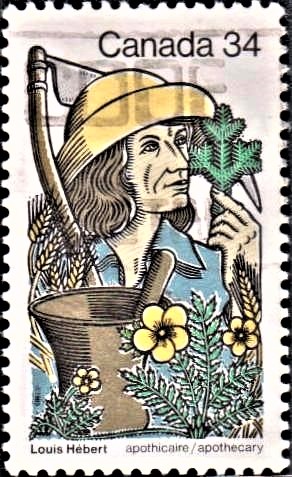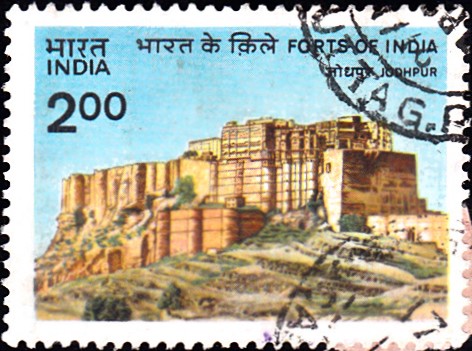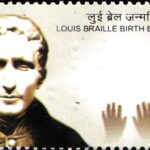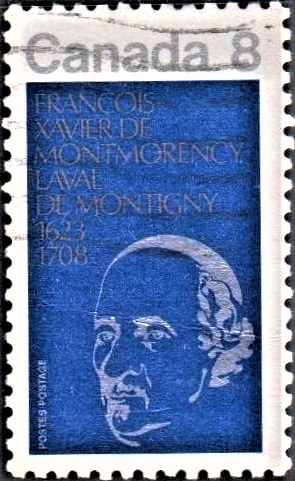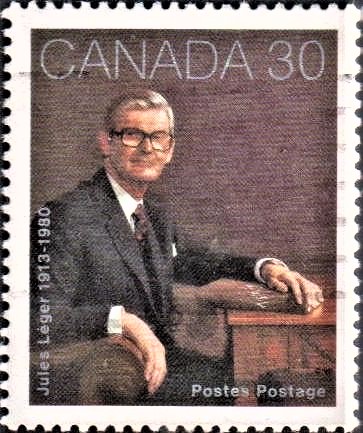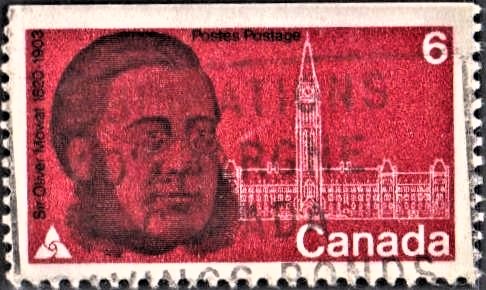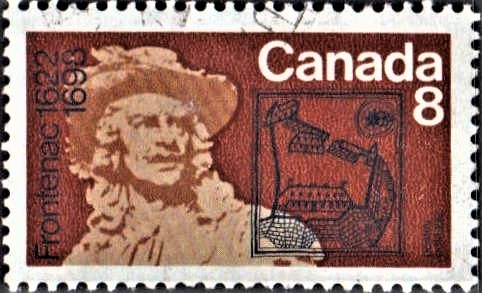
Frontenac
A commemorative postage stamp on Louis de Buade, Comte de Frontenac et de Palluau, the Governor–General of New France [Comte de Frontenac, Gouverneur Général de la Nouvelle–France] :
 Issued by Canada
Issued by Canada
Issued on May 17, 1972
Issued for : The Canada Post Office honours Frontenac‘s coming to New France as Governor General in 1672. [Les Postes canadiennes émettent un timbre pour marquer la venue de Frontenac en Nouvelle-France, en 1672, à titre de gouverneur général.]
Design : The stamp, designed by Laurent Marquart, is printed in one colour steel and two colour gravure. [Le timbre, dessiné par Laurent Marquart, est imprimé en une couleur par le procédé de la gravure sur acier.]
Type : Stamp, Postal Used
Denomination : 8 Cents
Size : 40 mm x 24 mm
Quantity : 26,000,000
Plate Number : 1
Printing Process : This stamp is printed in one colour (blue) steel, and two colour (beige & brown) gravure, marginal inscriptions including the designer’s name will appear on the four corners of each pane of 50 stamps available from the Philatelic Service.
Printer : British American Bank Note Co. Ltd., Ottawa
Name : Louis de Buade, Comte de Frontenac et de Palluau
Born on May 22, 1622 at Saint–Germain–en–Laye, France
Died on Nov 28, 1698 at Chateau St–Louis, Quebec City, New France, French colonial empire
About :
- Frontenac came to New France for the first time in 1672. He had been appointed Governor of the French colony in America, a position that he held from September 1672 until September 1682, when he was recalled to France, and from October 1689 until November 1698. As Governor, Frontenac was the representative of Louis XIV. It has long been accepted that he was the greatest of the king’s representatives in New France.
- The postage stamp issued to commemorate this anniversary shows Philippe Hébert‘s statue of Frontenac which is in Quebec City. In the background appears a sketch of Fort Saint–Louis, Quebec, residence of the Governors of New France, as it was at the time of Frontenac‘c arrival. During Frontenac‘s second term of office, many important changes were made to the fort at his request.
- Louis de Buade, comte de Frontenac et de Palluau, was born on May 22, 1622, at Saint–Germain, France, the son of an old family of the “noblesse d’épée”. He derived the title of Frontenac from the name of a family estate in Guyenne. In 1648, he married Anne de la Grange–Trianon. While she never came to New France, she served her husband’s interests through her influence at the court of the King of France. A military man at heart, Frontenac was named “maréchal de camp“, which today would be equivalent to the rank of brigadier. Like many noblemen of this era, he was very extravagant and greatly in debt. He was soon impoverished and this circumstance led him to accept the position of Governor of New France.
- As Governor, Frontenac had authority in military matters. However, during his first term, he neglected this principal responsibility in favour of territorial expansion to increase the lucrative fur trade. For this reason, in 1673 he founded Fort Frontenac, a trading post on the shores of Lake Ontario, where the city of Kingston now stands. In October 1689, when appointed Governor for the second time, Frontenac received more specific instructions concerning the defence of the colony. He discharged his duty on two important occasions. First, in 1690 he repelled an attack on Quebec City by a force from the British colonies led by Admiral William Phipps. Secondly, in 1696, Frontenac undertook a campaign against the Iroquois, whose attacks seriously endangered the colony. This campaign resulted in the peace treaty of 1701.
- During the major part of the year, Frontenac stayed at Fort Saint-Louis in Quebec City, where he lived in a grand style and gave sumptuous receptions. He died in Quebec City on November 28, 1698. His widow survived him until 1707. Their only son, François–Louis, born in 1651, died in 1672 or 1673.
- A man of bold and dynamic personality, Frontenac was an influential figure in the early history of Canada. He is best remembered as the architect of French development in North America and the defender of New France against the attacks of the Iroquois nation and the British colonies to the south.


